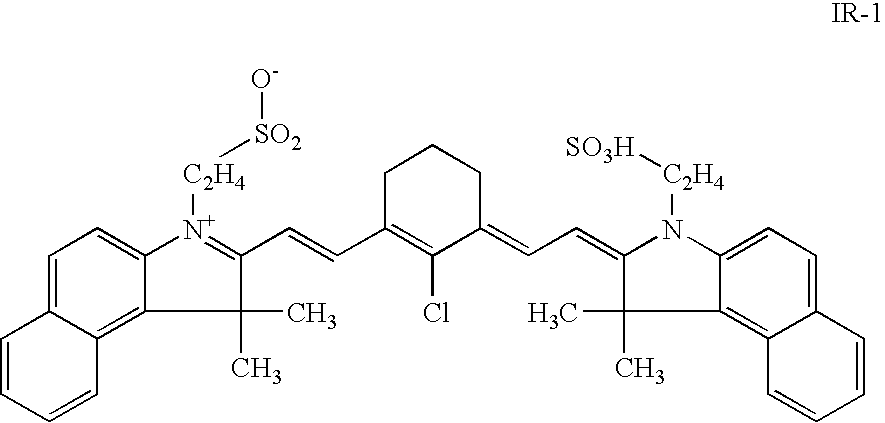Method for making a lithographic printing plate
a lithographic printing plate and negative printing technology, applied in the field of negative printing plate and heat-sensitive lithographic printing plate, can solve the problems of high sensitivity, high run-length during printing, and long exposure time and/or high-power laser, and achieve complete and profound removal (i.e. clean out) of non-exposed areas, improve sensitivity, and improve press life
- Summary
- Abstract
- Description
- Claims
- Application Information
AI Technical Summary
Benefits of technology
Problems solved by technology
Method used
Image
Examples
example 1
[0061]After imaging, the plate precursor 1 was processed in an Agfa VA88 processor, operating at a speed of 1 m / min and at 23° C., using a carbonate buffer with / without a surfactant (Table 2).
[0062]After development, the plate was gummed with RC795 (trademark of Agfa).
[0063]The occurrence of stain on the obtained printing plates was determined (Dmin).
[0064]
TABLE 2developer solution comprising a carbonate buffer andLibrateric AA30DeveloperpHDmin42 g / l NaHCO3 + NaOH to pH:10.870.35Comparative example8 ml / l Librateric AA30 (1) + 42 g / l11.00.09NaHCO3 + NaOH to pH:Invention example(1) surfactant commercially available from Libra Chemicals Limited, Manchester UK.
[0065]The data of Table 2 show that the addition of Librateric AA30 to the developer solution comprising a carbonate buffer improves the Dmin value. A Dmin value<0.1 is defined as no stain.
example 2
[0066]After imaging, the printing plate precursor 1 was processed in an Agfa VA88 processor, operating at a speed of 1 m / min and at 23° C., with a developer solution comprising a phosphate buffer with / without a surfactant Genapol C200 or Librateric AA30 (Table 3).
[0067]After development, the plates were gummed with RC795 (trademark from Agfa).
[0068]
TABLE 3developer solution comprising a phosphate buffer andGenapol C200 or Librateric AA30Surface TensionDeveloperPHDminmN / m4.4 g / l NaH2PO4 + NaOH to pH:10.970.1172.3Comparative example33 ml / l Genapol C200 (1) + 4.4 g / l10.870.06341.2NaH2PO4 + NaOH to pH:Invention example6.8 ml / l Librateric AA30 (2) + 4.4 g / l10.80.05439.6NaH2PO4 + NaOH to pH:Invention example(1) surfactant commercially available from Clariant GmbH, Frankfurt am Main Germany;(2) surfactant commercially available from Libra Chemicals Limited, Manchester UK.
[0069]The data of Table 3 show that the addition of Genapol C200 or the addition of Librateric AA30 to the developer sol...
example 3
[0070]After imaging, the printing plate precursor 1 was processed in an Agfa VA88 processor, operating at a speed of 1 m / min and at 23° C., with a developer solution comprising a silicate buffer with / without a surfactant Genapol C200 or Librateric AA30 (Table 4).
[0071]After development, the plates were gummed with RC795 (trademark from Agfa).
[0072]
TABLE 4developer solution comprising a silicate buffer and GenapolC200 or Librateric AA30Surface TensionDeveloperpH DminmN / m1 ml / l10.80.11972potassiummetasilicateComparative example1 ml / l10.740.07241.4potassiummetasilicate + 33 ml / lGenapol C200 (1)Invention example1 ml / l10.80.07637.8potassiummetasilicate + 6.8 ml / lLibrateric AA30 (2)Invention example(1) surfactant commercially available from Clariant GmbH, Frankfurt am Main Germany;(2) surfactant commercially available from Libra Chemicals Limited, Manchester UK.
[0073]The data of Table 4 show that the addition of Genapol C200 or the addition of Librateric AA30 to the developer solution com...
PUM
| Property | Measurement | Unit |
|---|---|---|
| particle size | aaaaa | aaaaa |
| particle size | aaaaa | aaaaa |
| particle size | aaaaa | aaaaa |
Abstract
Description
Claims
Application Information
 Login to View More
Login to View More - R&D
- Intellectual Property
- Life Sciences
- Materials
- Tech Scout
- Unparalleled Data Quality
- Higher Quality Content
- 60% Fewer Hallucinations
Browse by: Latest US Patents, China's latest patents, Technical Efficacy Thesaurus, Application Domain, Technology Topic, Popular Technical Reports.
© 2025 PatSnap. All rights reserved.Legal|Privacy policy|Modern Slavery Act Transparency Statement|Sitemap|About US| Contact US: help@patsnap.com

